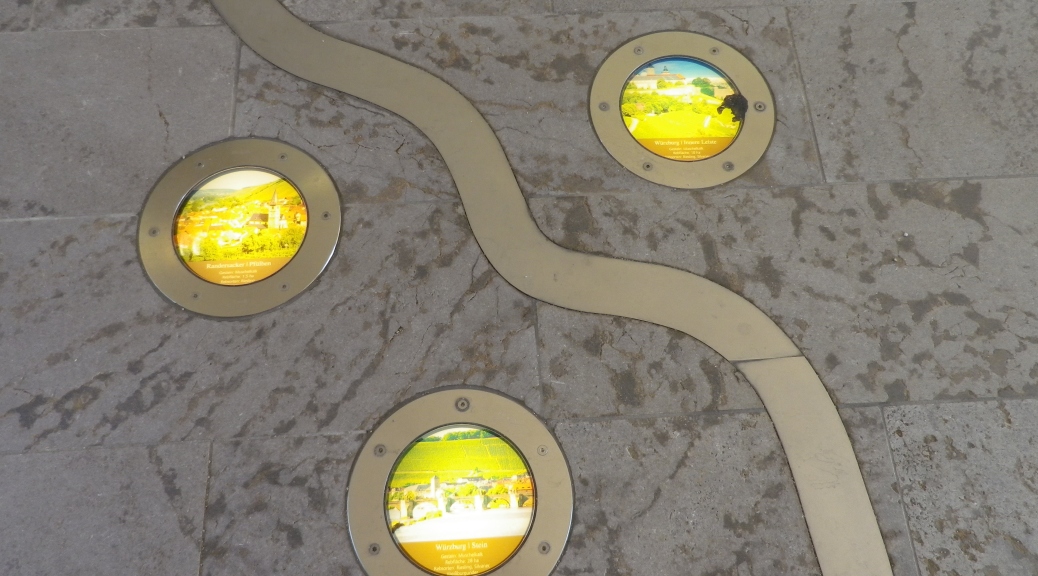What I Learned:
Along the Main River in Franconia (Franken, in German), there are three wine districts of good repute: Maindreieck, Mainviereck, and the Steigerwald, set slightly off the river, but still enjoying a climate mild enough to grow grapes. This post focuses on the Maindreieck district only.
The Maindreieck is a triangle of land surrounded on three sides by the Main River. The Main is a tributary to the Rhine. The river makes three dramatic curves close to the heart of Franconia, forming this “peninsula” as a paragon of viticulture in south central Germany. The most important and undoubtedly best known town for wine culture in this area is Wuerzburg.
There are some very well-known vineyards in this district. Within the precincts of Wuerzburg, there are the Innere Leiste, situated just below the walls of the imposing Fortress Marienburg; and the Wuerzburger Stein. Just outside Wuerzburg, within the precincts of the wine village of Randersacker, there are three: the Randersackerer Teufelskeller, Pfulben, and Sonnenstuhl. Volkach has also three: the Eschendorfer Lump, the Volkacher Ratsherr, and the Volkacher Kirchberg, the Kirchberg, “church mountain,” refers to the Maria im Weingarten (Mary in the Vineyards) pilgrimage church situated cozily among the vines. The Wine Island has the Sommeracher Katzenkopf and the Nordheimer Voegelein. With so many premier sites (Erste Lage), Franken wines can be quite good.
Major Franken Grape Varietals:
Silvaner: This varietal has been grown in the Franconia area since the 17th century, and is one of the more important varietals for this particular area. Many locals prefer it over Riesling.
Mueller-Thurgau: This hybrid varietal is also known as Rivaner, and produces a light, fruity wine. In Franconia, it is traditionally more widely planted than Silvaner.
Riesling: Riesling wine is the most planted varietal in Germany, but less so in Franconia. Here, true to form, many Riesling wines take on a mineral flavor determined by the soil.
Scheurebe: Especially famed in the Steigerwald area, wines from this varietal find particular favor and renown in this region overall.
Domina: This red wine varietal, a cross between Spaetburgunder and Portugieser, is fairly recent.
What I Tasted:
2012 Silvaner, Wuerzburger Stein, Qualitaetswein, Trocken, Juliusspital (Wuerzburg): A dry white wine with a light medium gold color; a sweet-smelling bouquet, with hints of floral, honey and dried fruit; Well-balanced, and very slightly tart, medium body and mouthfeel.
2012 Riesling, Sommeracher Katzenkopf, Weingut Rainer Wohlfahrt: A dry white wine, minerally, tart, refreshing, light to medium body.
2012 Silvaner, Volkacher Kirchberg, Kabinett, Weingut Markus Schneider: A dry white wine with a minerally taste, full-bodied, long finish, very refreshing.
2012 Silvaner, Sommeracher Katzenkopf, Trocken, Winzer Sommerach: A dry white wine with substantial mineral content, slight green apple-tart taste, tingly on tongue, light to medium body.
2012 Silvaner, Gaibacher Alte Reben, Weingut Graf von Schoenborn: A dry white wine with complex flavors, minerally, fruity (grapes predominate), medium body.
2011 Spaetburgunder, Terra Consilium, Spaetlese trocken, Thueringsheimer Ravensburg: A medium-bodied red wine, colored a darker red than expected for a pinot noir, with a spicy, chalky, minerally taste, full of flavors of wild berries.
2011 Domina, Volkacher Ratsherr, Weingut Karl Mueller, Qualitaetswein, Trocken: A dry red wine, from a hybrid grape not often seen elsewhere, full-bodied, cherries, oak. Close to a northern Italian red in mouthfeel and aroma.
2011 Domina, Juventa, Divino Nordheim, Qualitaetswein, Trocken: This dry red was not as dry as the Volkacher above, nor as full-bodied, but still has wonderful cherries and oak flavors.
